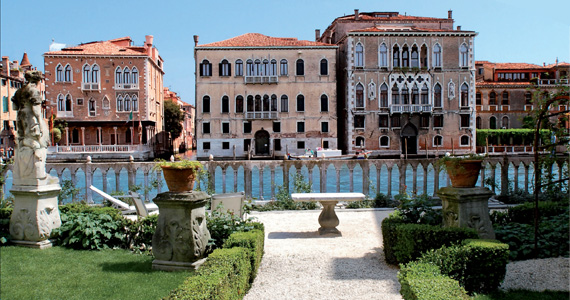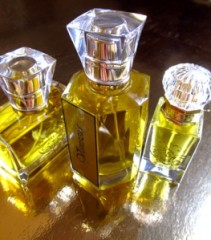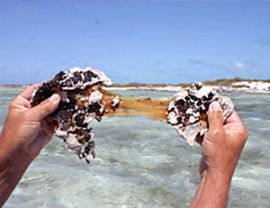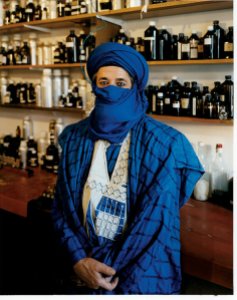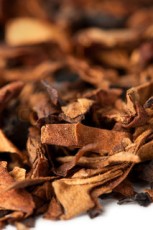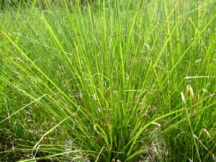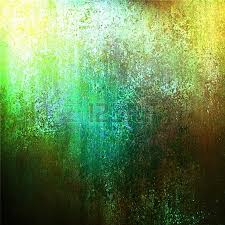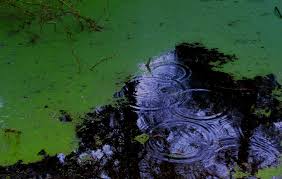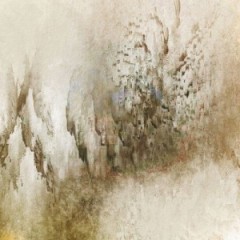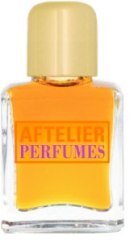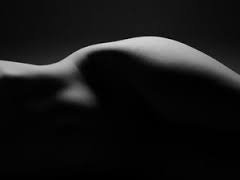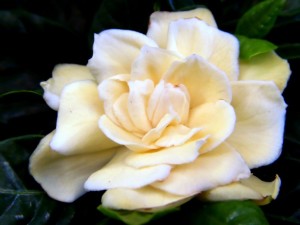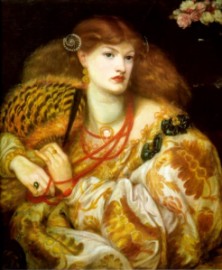
“Monna Vanna” by Dante Gabriel Rossetti.
One of my favorite periods in art is the Pre-Raphaelite movement led by Dante Gabriel Rossetti. His exquisite beauties with almost translucent ivory skin and their manes of Titian-red flames stare at you with large, haunted eyes and seemingly quivering lips. Their graceful bodies are either garbed in ornate furs or velvets, or are the embodiment of simplicity against the lushness of nature. In all case, though, they always straddle the line between prim daintiness and richness, delicacy and sensuality, darkness and light.
The Pre-Raphaelite Brotherhood repeatedly came to mind when I wore Moon Bloom, a fragrance centered around the richness of white flowers, particularly tuberose. Yet, it wasn’t my favorite, Dante Gabriel Rossetti, with his ornate beauties who the perfume conjured up.
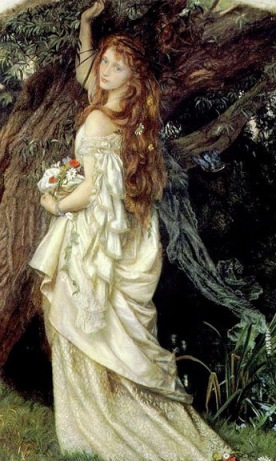
“Ophelia” by Arthur Hughes. Source: preraphaelitesisterhood.com
Instead, it was the various portrayals of Ophelia by other members of the brotherhood, from John William Waterhouse to Arthur Hughes. The key is the radiance of an Ophelia who glows white, embodying delicacy, gracefulness, warmth and femininity in the midst of very measured, very calibrated, careful lushness. For me, that is the essence of Moon Bloom.
Moon Bloom is an all-natural, handcrafted eau de parfum that released in 2013, the debut creation of Hiram Green Perfumes. The perfume house is based in the Netherlands, but was founded by a British gentleman, Hiram Green, who has quite a background with perfumery in general. His website explains further:
After founding Scent Systems, a perfumery located in central London, Hiram learnt that most perfumes, even the ‘best quality’ ones, are manufactured using synthetic materials. Wanting to offer a natural alternative to his customers, he was hard-pressed to find anything suitable.
After relocating to the Netherlands, Hiram spent several years researching and experimenting with natural fragrant materials. In his studio in Gouda he develops and produces his natural fragrances in small batches.
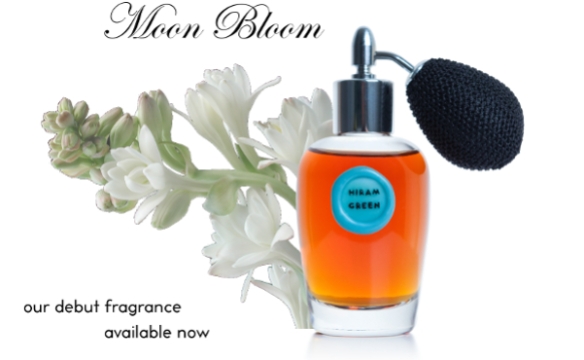
Moon Bloom via the Hiram Green website.
I love the look of Moon Bloom which comes is a glass bottle with an old-fashioned black atomizer “poofer” (as I call it) pump, dark ambered liquid, and a turquoise wax seal. The description for the fragrance may be even prettier, as it uses a phrase I’d never previously heard in connection with my favorite flower. “The mistress of the night.” I shan’t forget it. Even though I see tuberose as the exquisite embodiment of whiteness, enough people find its narcotic qualities to be overwhelming and utterly evil, thereby making “mistress of the night” quite an apt, very amusing moniker of darkness.
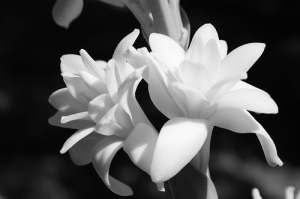
Source: Fragrantica
The perfume’s full description reads:
Moon Bloom is a lush and elegant tuberose themed eau de parfum. Tuberose is a tropical night blooming flower. Often referred to as ‘the mistress of the night’, tuberose is an admired theme in perfumery because of its soft and creamy but also powerful and narcotic aroma.
Moon Bloom includes generous amounts of tuberose absolute, jasmine absolute and ylang ylang. There are also notes of coconut, leafy greens and hints of tropical spices and resins.
Moon Bloom opens on my skin with green, fresh tuberose that has a very mentholated, chilly, rubbery note. I have to admit, I muttered to myself, “here we go again.” It’s undoubtedly unfair to have a bias against the eucalyptus-like, chilled metal opening of many modern tuberose scents. After all, the deconstructed essence of the flower and their indoles often has that precise profile. Still, I’m not a particular fan of it, especially when it takes on the merest whisper of mothballs, the tell-tale sign of truly concentrated or undiluted indoles. Thankfully for me, both the mothballs and the hardcore, rubbery, mentholated intensity fade away within mere minutes. Less than 4 actually, so it truly doesn’t last long on my skin, though a certain chilly coolness does linger for another hour.
 The opening moments are a contrast of light and dark. The tuberose is followed almost immediately by a touch of sweet jasmine and by milkiness. Though the dark, rubbery mentholated camphor fades quickly, there remains a light greenness that lurks around the edges. At the same time, the tuberose feels lush, opulent and heady, with indoles that almost border on the dirty. The sweetness of the jasmine grows in strength, flitting all around the top notes, intertwined inextricably with the potent tuberose. The whole thing is warm and rich from the start, with a spicy quality that hints at the base elements.
The opening moments are a contrast of light and dark. The tuberose is followed almost immediately by a touch of sweet jasmine and by milkiness. Though the dark, rubbery mentholated camphor fades quickly, there remains a light greenness that lurks around the edges. At the same time, the tuberose feels lush, opulent and heady, with indoles that almost border on the dirty. The sweetness of the jasmine grows in strength, flitting all around the top notes, intertwined inextricably with the potent tuberose. The whole thing is warm and rich from the start, with a spicy quality that hints at the base elements.
While Moon Bloom’s opening minutes definitely shares the deconstructed tuberose element of Serge Lutens‘ Tubéreuse Criminelle, I find definite differences between the two. It’s not merely the length of time that each note lasts. It’s also that the note never smells like diesel or gasoline. After the opening salvo, it feels more like a touch of smoky darkness that is replaced by icy menthol. At times, the latter almost feels fizzy, like the aerated champagne bubbles in YSL‘s vintage Champagne or Yvresse. The flood of sweet jasmine also ensures that the indoles don’t stay rubbery or too medicinal for long.

Source: crazy-frankenstein.com
There is another great white flower that I smell, crazy as it sounds. On every occasion when I’ve worn Moon Bloom, there is a core note of what I would swear is gardenia. I thought I was completely mad, as there is no gardenia whatsoever in Moon Bloom. So I wrote to Mr. Green about it, and he replied: “I think of gardenia absolute as smelling between Jasmine and Tuberose. It would not surprise me then if you smelt gardenia in Moon Bloom.” Mr. Green is a very courteous gentleman, so he may have been trying to make me feel better, but I’m going with his explanation. From this point on, I’ll just write “gardenia” in quotes so that you know I’m referring to the oddity of my own nose.
As a whole, Moon Bloom quickly turns into a rich tuberose and jasmine duet with the lightest touch of both greenness and darkness. My favorite part may be the coconut. It’s actually more like vaguely coconut-y, floral milk, than actual heavy, gooey, Hawaiian Tropics butteriness. It’s a delicate, initially watery, soft note that is never cloying or unctuous, though it is quite muted and muffled. For most of Moon Bloom’s lifespan on my skin, the coconut works in the shadows, adding an indirect effect to the base notes and providing a textural quality more than an actual smell of milkiness.

White opal via swissgemshop.ch
“Radiant” may be the best description for Moon Bloom, despite its initial potency and indolic quality. Contrary as it may sound, the perfume feels more radiant and delicate than carnal, fleshy, and over-ripe. It’s a dainty take on a floral powerhouse, and the soft, airy quality that takes over after 20 minutes underscores that impression. Instead of evoking pillowy, fleshy bosoms on languid courtesans, instead of the hot, almost opaque excesses of Fracas (which I love for precisely that reason), Moon Bloom makes me think of an opal stone with its touch of iridescence amidst a milky smoothness. Perhaps its the name of the fragrance with its imagery of flowers blooming in the silvery light of the moon, but I think it’s Moon Bloom’s radiant quality that feels like a perfectly calibrated mix of lushness and bright freshness.

Photo: onewomanshands.blogspot.com
20 minutes in, Moon Bloom starts to shift. The “gardenia” note grows stronger. Here, it is simultaneously a very dewy, green “gardenia” like the version in Ineke‘s Hothouse Flower, and also a lusher, richer interpretation of it. I realise that it is probably the jasmine, but regardless of the actual source, I love the creaminess with its contradictory freshness. The tuberose-jasmine duo still dominate, but the “gardenia” definitely trails in third place. The flowers feel almost weightless, a little too much so for my personal tastes. On my skin, the jasmine is far meatier and richer than the tuberose which feels utterly translucent at this stage. Around the same time, Moon Bloom’s projection drops. It was initially extremely strong, but is now an airy cloud that hovers 2 inches above the skin with 3 spritzes from a little atomizer.
The prominence and role of the individual flowers in Moon Bloom are really interesting. After wearing the fragrance a number of times in the last month, I’ve noticed what seems to be a trend in the perfume’s overall development. Moon Bloom always begins with tuberose, but it then goes through stages where other flowers seem to take over. It feels like a horse-race where the tuberose bursts out of the gate, but becomes neck-and-neck with the other flowers after thirty minutes. First, it is jasmine which surges ahead by a nose, and stays there for the first few hours. Then, its place is taken by the “gardenia” which is heavily intertwined with the tuberose for the next stage. In the end, though, the tuberose returns to overtake them both on the home stretch, and races past the finish line. For me, that’s unusual as most tuberose-centered fragrances that I’ve tried inevitably end up finishing as jasmine or something else. Not Moon Bloom, though the tuberose is definitely in second place for long stretches of time.
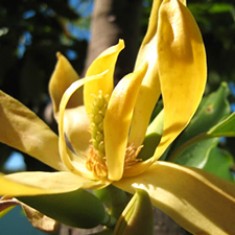
Ylang-Ylang. Source: Soapgoods.com
You may have noticed that I haven’t mentioned ylang-ylang in all this. Well, for the first thirty minutes, I can’t detect it at all. Then, almost on the dot, it appears, albeit in extremely muted form. It adds a velvety smooth texture, and, for a second, just the tiniest hint of something banana-like. At the same time, however, it is infused with an almost moss-like greenness at its edges that smells both leafy, and a wee bit reminiscent of Givenchy‘s vintage Ysatis, a ylang-ylang chypre. The greenness is quite separate from the lingering traces of menthol that remains at the edges, but the whole thing is extremely subtle, a bare flicker that only occasionally pops up.
45 minutes in, Moon Bloom is a seamless blend of jasmine, gardenia, tuberose, and ylang-ylang, in that order, with varying, subtle undertones of greenness that range from the leafy to the fizzy to the faintly mentholated. There is a quiet, muted spiciness that stirs in the base, tossing up a touch of gold to the very white, cream, and green coloured palette. The coconut milk has disappeared as an individual note, but it has a profound effect on the base when combined with the ylang-ylang. Thanks to the two elements, the plush, heady white flowers are nestled in a suede-like richness and warmth. I was going to say “custardy,” but that is not really accurate. Nothing about Moon Bloom feels heavy or thick. It’s too delicate to be like velvet, but too creamy to be an airy mousse.

Source: Fragrantica
Perhaps the best way to describe Moon Bloom’s perfectly calibrated, tight-rope act would be to describe the fragrance as “petal-soft.” It mimics the velvety softness that you feel when you stroke a gardenia’s petals and breath in its heady richness, but there is also the airy, fresh radiance of flowers that have not reached their peak or turned blowsy.
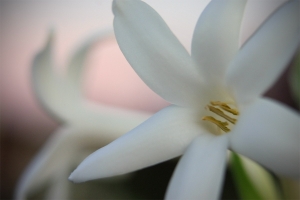
Photo: mypham.us
Moon Bloom turns more beautiful with time. Around the 2.5 hour mark, it’s a gorgeous “gardenia” and jasmine scent, infused with tuberose, upon the creamiest, velvety softness. It feels lush, but dainty, and I prefer all of it to Carnal Flower. Best of all, Moon Bloom lacks the Malle perfume’s synthetic base with that terrible, cheap white musk that always gives me a headache if I sniff Carnal Flower up close for too long. Instead, Moon Bloom’s base has an abstract (though muffled) spiciness to it which grows stronger, shedding a golden haze over the soft white flowers.
I find the balancing act that Mr. Green has achieved to be masterful, utterly masterful. He’s managed a refined, modern take on white flowers that never emasculates them or robs them of their true identity. He doesn’t reject their inherent lushness in favour of some ostensible, overbearing “freshness” done purely for the sake of appealing to current market trends. Moon Bloom has that modern vitality and lightness, for this is no Fracas or 1980s powerhouse after all. Yet, instead of aping Carnal Flower, he eschews pure greenness in favour of creaminess and yellowed warmth. (For me, visually, jasmine often skews a buttercup yellow on the colour spectrum, illogical as that may be.)

John Collier, “Queen Guinevere’s Maying” (1900). Source: Wikipedia.
Mr. Green has taken the best of both worlds — the old of Fracas and the new of Carnal Flower — and mixed them into a perfume that gleams like an opal. It has the subtle sensuality of Rossetti’s women, but at a sotto voce level, and countered by the delicate beauty of the Ophelia of his Pre-Raphaelite brethren. There is the luxurious feel of old-style, full-bodied, classique perfumes, but, also, the lightness, airiness, restrained discreetness and brightness of the modern style. Finally, Moon Bloom balances the cool aspects of a green freshness with the warmth of that creamy base, a base whose golden sunniness evokes the Queen of the May far more than “the mistress of the night.” Have I mentioned the word “masterful” yet?
At the end of the 4th hour, Moon Bloom hovers right above the skin, but the scent is so deep or rich that I’m amazed it’s all-natural. The perfume is a velvety-soft blur of white flowers led by the tuberose-gardenia-jasmine trio. The tuberose has finally overtaken its white cousins, as if the jasmine decided to give up the race. The “gardenia” impression continues, while the ylang-ylang is as muted as ever on my skin. The best part of the scent, apart from the return of the tuberose, is that surprisingly creamy base. After 5.25 hours, it feels smoother than ever with a plushness that is texturally very natural and more petal-like than ever. Carnal Flower, at a comparable point in its development, had nothing like it, and was merely a blur of musky jasmine. Moon Bloom has actual depth and body, yet its richness never feels overwhelming.
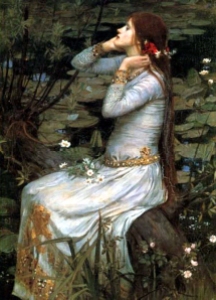
“Ophelia” by John William Waterhouse, 1910. Source: preraphaelitesisterhood.com
To the contrary, Moon Bloom’s drydown has a softness that borders on the soothing. It’s hard to explain, but there is something about that velvety, petal-like quality and Mr. Green’s perfect balancing act which creates an easiness about the scent. Moon Bloom is so much more comfortable than my beloved Fracas which is all about dressing up to the nines or to seduce. Moon Bloom has an accessible gentleness, but it’s an easiness that never once surrenders its creamy white soul or loses sight of what white flowers are really like. Nothing about the scent feels like a generic, banal, white flower cocktail that you could find at Sephora, but it’s also not a diva act. All of which bring us back to Ophelia. If Fracas is the iconic Maria Callas in diamonds and furs, then Moon Bloom is a Pre-Raphaelite Ophelia. Graceful femininity with seamless smoothness and an absence of rough edges (or synthetics) done in a way that makes the white flowers radiant and soft, but never showy or bold.
In its final hours, Moon Bloom is a velvety tuberose with occasional flashes of “gardenia.” It coats the skin like a whisper, but there is a richness to the tuberose if you put your nose right on your skin. I’m amazed at Moon Bloom’s longevity on my wonky skin. Three good squirts from the little atomizer, or the equivalent of 2 small sprays from a regular bottle, gave me 11.5 hours in duration. One big atomizer squirt gave me about 9 hours, though the sillage dropped much more rapidly and Moon Bloom became a skin scent after 2.5 hours. On Fragrantica, the few votes for longevity are evenly split between “long lasting,” “moderate,” and “weak,” while the sillage numbers are primarily for “moderate,” followed by 1 vote for “heavy.” I really think that the quantity you apply will impact both issues, as well as, obviously, your skin chemistry.
As you can tell, I loved Moon Bloom. It’s a lovely scent that falls midway on the spectrum between Carnal Flower‘s fresh greenness and subdued restraint, and the more indolic variations on tuberose. It’s a far, far cry from Fracas (or even the indolic jasmine powerhouse of La Via del Profumo’s Tawaf), but it’s also removed from Carnal Flower. It feels like a perfectly calibrated mix of both, with strong touches of its own character.
That said, I’m someone whose tastes skew strongly toward super opulent, bold, powerhouses when it comes to my florals, so you need to put my assessment into that definitional context. If you’re someone who finds Carnal Flower to be too intense a white flower explosion, then I do not recommend Moon Bloom. If you can’t stand tuberose or jasmine, then, quite obviously, you should stay far, far away. Moon Bloom is for those who find Carnal Flower to be too anemic or wispy, but who also think Fracas is taking lush richness too far to the other extreme.
My definitional standards and preferences might be firmly placed on the extreme side of the white flower scale, but I’m far from being alone in finding Moon Bloom to be lovely. The perfume has won over many bloggers, with a number of them placing it on their Best of 2013 list. Take, for example, the witty, lovely Victoria of EauMG who writes, in part:
Moon Bloom is a minty, green tuberose with a creamy banana ylang-ylang. It’s huge and luscious and dare I say glamorous! Indoles fall out of jasmine’s cleavage when she bends forward. Her glistening skin is subtly moisturized with coconut oil and this adds a warmth to the white florals. The florals become more “peachy” and lose some of their crisp greenness. Moon Bloom’s dry-down is acrid incense with “green” coconut.
Moon Bloom is glamorous and flawlessly put together. I realize that my description or even the note list may scare away some people that have white floral “issues”; however, please don’t let it. Moon Bloom is big but subtle. It’s one of the few tuberose perfumes that allows you to be the diva and doesn’t try to steal your spotlight. I really think this one will win over those timid of tuberose. And it will be loved by those that adore white florals. I can’t stop sniffing it when I wear it. It’s gorgeous and it makes me feel gorgeous. […]
Moon Bloom has average projection and longevity. In my opinion, it wears for much longer than other all-natural compositions. I get 6-8 hours. It does become more subtle after 2-3 hours but that’s fine with me. […]
Victoria’s Final EauPINION – Gorgeous, glamorous tuberose soliflore. I think Mr. Green just helped a lot of perfumistas find “their” tuberose. This is the easiest to wear straightforward tuberose soliflore that I’ve ever encountered.
Victoria loved it so much that she put it on her Best of 2013 list, but she’s not alone in appreciating Moon Bloom. The Perfume Shrine put the fragrance in a tie with Aftelier’s Cuir Gardenia for their Best Natural of 2013. And Olfactoria’s Travels thinks it’s great as well.
Olfactoria writes that she has a very cautious relationship with tuberose, though she no longer has outright hatred for the note. In Moon Bloom, she found the flower to be “perfectly balanced,” soft and with “no hint here of the hysterical, diva-esque antics” that many tuberose fragrances display. On her skin, the florals eventually “recede a bit and a base emerges that is warm, a tiny bit spicy (think carnation/clove) and cosy in an unsweet, ambery (vanilla/labdanum) way.” As a whole, Moon Bloom evoked a woman whom she found to be
extremely sympathetic. I feel myself drawn to her and her charmingly enticing ways. She is intelligent, calm, she knows who she is. She is beautiful and desirable, but she doesn’t use that as a weapon, it is merely a fact of her life, equal among many. She loves to smile and there is an air of mystery around her, but this doesn’t make her appear aloof or remote, but draws you in closer, wanting to find out more.
What stands out most about this woman though, is her smile: warm, loving, caring and infinitely sweet, it is hard to remain untouched when you find yourself in the radiant presence of that smile.
Warmth is a far cry for what one adoring blogger perceived in Moon Bloom. My favorite review of the fragrance comes from The Silver Fox, a blogger who admittedly loves white floral bombs, but who has tried enough of them to know that Moon Bloom is special. He begins his review with fantastic elucidation of why it can be so cool for men to wear fleshy white flowers:
For me, a man wearing white florals is the subversive writhing of indolic strangeness, the blush of purity degraded, underpinned by the all too sexual skin washes of tuberose, lilies, ylang, gardenia and orange blossom. It is the fleshy conflict between light and dark, beauty and decay, sex and chastity that fascinates me.
In many ways these are overtly female blooms, but I adore transgression as many of you know. Boys smell so decadent in florals, so Tennessee Williams, muscular, tense and ambiguous, afraid of inner desires yet reaching out to embrace them. […][¶]
Hiram Green’s luscious, alabaster Moon Bloom is probably one of the best tuberose soliflores I have tried in many years. This shocked me for several reasons. One, I thought I had probably tried as many permutations and plays on the blooms as were strictly speaking possible and two, Hiram’s delicious scent is made exclusively from natural ingredients, a notification that does not generally make my Foxy heart sing.
Moon Bloom is creamy, glittering perfection. The name is so alluring and romantic, exactly right for this narcotic formulation of floral wonder. It is a strangely intense perfume, inhaling it transports me to frozen streets pierced by milky shafts of moonlight in a silent city. Snow falls, marble glistens, time slows. My skin is waxen, radiating the ivory effulgence of tuberose and jasmine absolutes. A lick of distant tropics from an ice-cold coconut note, green and glacial at the same time.
I highly recommend reading the entirety of his long but absolutely stellar, beautifully evocative review. There, he talks about why Mr. Green’s technical balancing act with the essential absolutes is so masterful, as well as offering further details of how the tuberose appears, the “pearlescent” jasmine, and the key impact of the coconut milk in his version of Moon Bloom. For him, the latter reminded him “of the wonderful oozing ripe fig effect used in the Extrème version of Premier Figuier by L’Artisan Parfumer.” He ends his fantastic analysis with these powerful images:
Moon Bloom is made for night skin, waxen and white-lit under bleak staring moons. A fragrance for skins in troubled love, in pain, lost perhaps. There is alchemy at work here and it smells like snow falling in the hush of night.

“Moon in the billowing mists” by Norroen-Stjarna. http://www.deviantart.com/art/Moon-in-the-billowing-mists-306095826
The Silver Fox seems to have experienced a lot more of the freezing, “iced metal” aspects of the menthol that either I or the other bloggers did, but it’s all a matter of skin chemistry. For me, Moon Bloom is not about “billowing snow,” and my skin did not bring out “a dazzling blindness to the carnal theme of Hiram’s whiteness, the kiss of frozen lips in a city paralysed by ice and the swirling rogue of winter flurries.” (What a spectacular piece of writing!) In fact, the concept of carnality never once crossed my mind with Moon Bloom, which just goes to show you how much one’s yardstick matters in assessing indolic florals. In fact, I’m starting to wonder just how much my childhood imprinting with Fracas and my subsequent love for Amouage-like Middle Eastern opulence has impacted my definitions, because I thought Tawaf was the embodiment of carnal voluptuousness, while Moon Bloom seems so lady-like and approachable.
To be clear, The Silver Fox does largely agree with that as well, writing extensively about how the tuberose is never lascivious or extreme. As he so amusingly puts it, the tuberose of Moon Bloom never screeches like a “drunken karaoke singer belting out gay anthems” who has to be tackled by his mates to shut up. For him, the tuberose is thankfully “far removed from this pitiful spectacle. It is strong-willed, full of drama, but intelligent and deeply charismatic, filling the room with brilliant, searching light.”
As you can see, the word “intelligent” keeps coming up in connection with Moon Bloom, along with “calm,” “approachable,” or “radiant” in descriptions that emphasize how the tuberose is not divaesque. And it’s true. This version is not the Ride of the Valkyries, and it’s not just my wonky, skewed perception. I love Fracas, but she’s not always the easiest thing to wear on a daily basis. Moon Bloom is.

Moon Bloom bottle and decant, via Hiram Green.
Moon Bloom is available in two different sizes. There is an affordable 5 ml decant sold for roughly $27 (or €25 with the VAT), while the full bottle costs about $150 with a more affordable refill option being introduced later this year. The original bottle is gorgeous, though, with the perfect blend of classicism and clean-cut modernism.
All in all, if you’re a white flower lover, I strongly recommend that you try Moon Bloom. For those with a much more tenuous relationship to the florals, I think you have to like both the initial mentholated aspect and a touch of indoles to enjoy the scent. On the other hand, Olfactoria who is iffy on tuberose really liked Moon Bloom, so perhaps you will too. As a whole, I think Moon Bloom skews more feminine than unisex, but in all cases, its relatively moderate longevity and soft sillage make it suitable for the office.
I have to end this long review with a simple word about Hiram Green: talented. Enormously talented. His debut effort is an utterly masterful display of technical brilliance. Bravo.
Disclosure: My sample was courtesy of Hiram Green. That did not impact this review. I do not do paid reviews, my views are my own, and my first obligation is honesty to my readers.
DETAILS:
Cost & Availability: Moon Bloom is an eau de parfum that comes in a 50 ml bottle that costs €111.57 for non-European customers and €135 for European ones who have to pay VAT. It is available the Hiram Green website, which also sells a 5 ml decant for €20.66 without VAT, and €25 with the tax included. Later this year, a cheaper refill option should be available. I believe the current bottle and decant are also refillable at the current time. Whichever bottle you choose to get, the website will automatically subtract or add the VAT based on your delivery address. ships its scents world-wide. In the U.S.: There are no US retailers at this time. You have to order from Hiram Green, or from one of the European vendors which carries the line. [UPDATE 7/9/14: Moon Bloom has now come to the U.S. and is exclusive to Indigo Perfumery which sells the full bottle for $165, with the 5 ml travel spray for $40, and a sample for $4.] Outside the U.S.: Moon Bloom is available at 7 European retailers. One is First in Fragrance which ships world-wide and which sells Moon Bloom at retail for €135, with a sample for €8. In the Netherlands, Amsterdam’s Annindriya Perfume Lounge sells both the 50 ml bottle and the 5 ml decant size. Other vendors are in Austria, Germany, and Sweden. They are listed on Hiram Green’s Stockist Page. Samples: I could not find Moon Bloom at this time on either Surrender to Chance or The Perfumed Court. I will try to update this section if the fragrance becomes available at either one.

